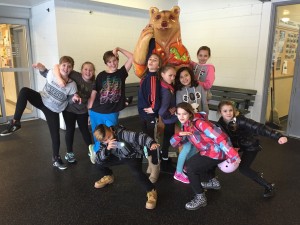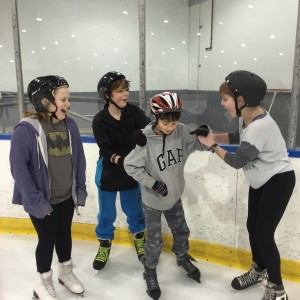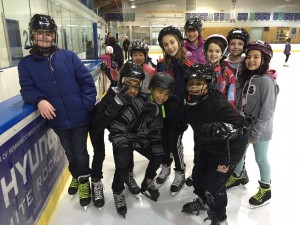The Drumming Lesson
Today at Sunnyside I took on my riskiest lesson yet — drumming. Going into this lesson I was slightly nervous because not only was it going to be a first experience for many of the students within the class, but it was also going to be my first experience taking on a music lesson.
In addition to the nerves I had going into this lesson, the preparation required for this lesson was also complicated and I knew that my timing and execution had to be flawless for everything to go smoothly. Since the music room is booked all day during our Thursday visits to Sunnyside, I arranged for our drumming lesson to take place in the portable outside of the school, in the hopes that we would not disrupt any other classes with the loud drumming. Since the lesson was planned for outside in the portable, this meant moving 30 large drums outside during lunch hour. Time and time again I am so impressed with how many students jump at the opportunity to help set up lessons, so luckily I had a lot of help accomplishing this daunting task.
Once the students were back inside after lunch the transition outside to the portable with the class was smooth and efficient. The kids were all beyond excited to start playing the drums. After we had settled into the portable, I re-stated my expectations and rules for the lesson, as I knew it had the potential to get out of hand considering the type of lesson it was. I first outlined my expectations for the lesson back inside the school before we left for the portable, so the students were all very aware of the ‘stop-drumming’ signal before we even left for the lesson.
After entering the portable I asked the students to take a seat in an empty desk and we played a rhythm game without the drums. This game went even better then I expected it to. This kids had a blast and wanted to play it over and over again, so we did. As we practiced the rhythms together as a class, we started performing the pattern faster and faster until the room erupted in laughter. This was a great moment. Next it was time to bring out the drums. As a class, we moved all of the desks out of the way, created a large circle in the middle of the room with the chairs, and I proceeded to hand out the drums. Before I handed out any drum sticks to students I talked about how it is important to respect the instruments, and I once again reminded them about the signal I would give them when I wanted them to stop drumming. This signal was 2 hands up over my head, holding one drum stick in each hand. Once I gave the students the go-ahead to start playing and experimenting with sounds and the drums they went absolutely crazy! It was awesome. The energy in the room was contagious. As the lesson progressed we experimented with sound, vibrations, pitch, tempo, and rhythm through a verity of different games and activities, all of which were extremely successful. In particular there was one game that the kids all went nuts over — the game ‘whats for dinner?’ In this game each student had an opportunity to speak and simultaneously drum out the rhythm of what they had for dinner as we went around the circle. They loved it. The laughter and their engagement during this part of the lesson is I think what every teacher strives for — it was simply amazing.
After completing all the games and activities, I separated the students into groups of 5 and their task was to create a 10-20 second song using the different rhythms of what they had for dinner. Additionally, each group had to notate their rhythms (song) on a big piece of paper, give their song a title, and create a band name. The groups of students all had about 20 minutes to work on their creations, and then it was time for the performances. I was absolutely blown away with the quality of the paper soundscape creations and the final drumming performances. Not only did each group completely understand my expectations for the assignment, but every single group created amazing drumming performances!! I so badly wish that I had video footage of the performances, as they were truly outstanding. It was amazing to see students, who had little to no rhythm at the beginning of the lesson, nail their rhythms in a group performance. No matter how hard I try, I will not be able to articulate though a reflection what an amazing moment this was for every single person within the class. Once each group took their turn on ‘the stage’ the classroom erupted in applause. This was exactly what I had hoped for.
Although so much of the lesson went better then I could have hoped for, it most definitely was a challenging lesson to manage at times. Overall, the students really did an awesome job refraining from drumming while I was explaining new activities or when other people were talking, but next time I may be a little firmer with a select few individuals who pushed the boundaries a little bit.
For me, one of the most special moments of the lesson was being able to connect with one of the more challenging students in the class. This particular student is quite disruptive on a regular basis and often has a hard time engaging in classroom activities; however, he absolutely loves music. While creating this lesson I had hoped that it would give me the opportunity to connect with this student more, and it did exactly that. Not only did he volunteer to help me set up, which is very uncharacteristic of him, but he was also so excited and engaged during the entire lesson. Additionally, he also took on an important leadership role during the lesson, helping many of his classmates become successful in their own drumming. In speaking with this student after the lesson, I feel as if his acceptance of me as a teacher in the classroom had done a 180 — this event alone made the lesson worthwhile.
As I move closer towards beginning my extended practicum, drumming is most definitely something that I want to continue with. I think there is so much value in learning how to play an instrument and connecting with music, not to mention the fact that the students had a blast.



